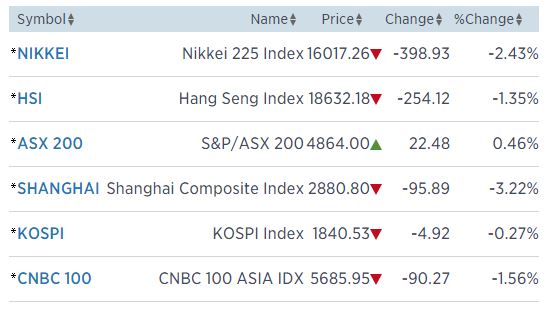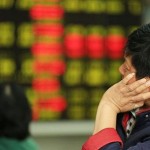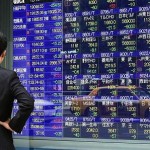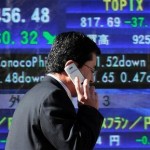Asia markets take another tumble as rout persists

Markets in Asia lost early gains and tumbled into negative territory in afternoon trade, following another selloff on Wall Street overnight on global growth concerns, uncertainty in China and fresh lows in oil prices.
The Shanghai composite touched its lowest level since December 2014, while Hong Kong’s Hang Seng index tumbled to a fresh three-year low in another late afternoon sell-off.
Klaus Baader, head of research for Asia at Societe Generale, told CNBC’s “Squawk Box” the selloff in equity markets have been “absolutely savage.”
“It has very much the feeling of capitulation. I think one of the main reasons why this is happening is there’s just so much uncertainty out there. And the uncertainty I think, in particular, relates to China and to what’s happening to the global currency construct, where is China’s [foreign exchange] policy going. That’s one of the things that’s really unsettling markets,” he said.
Japan’s Nikkei 225 retraced early gains to close down 398.93 points, or 2.43 percent, at 16,017.26, after trading up as much as 1.9 percent earlier in the session. That leaves the index deeper into bear country after losing 3.71 percent in Wednesday’s session. The index is down 22.57 percent from its 52-week high of 20,686.03, set in June 2015. TheTopix was down 37.48 points, or 2.80 percent, at 1,301.49.
Reuters, citing capital flows data in Japan, said foreign investors remained net sellers of Japanese stocks for the week ending on January 16, selling a net 358.3 billion yen worth of shares. The week before, they sold 746.4 billion yen.
According to reports, Bank of Japan Governor Haruhiko Kuroda said the central bank will stick to its 2 percent inflation target, adding Japan’s economic fundamentals remain firm.
Across the Korea Strait, South Korea’s Kospi see-sawed between gains of 0.68 percent at market open and losses before finishing down 4.92 points, or 0.27 percent, at 1,840.53.
Down Under, Australian shares closed before the regional sell-off took hold, with the ASX 200 adding 23.37 points, or 0.48 percent, to 4,864.90, buoyed by gains in the energy and materials sectors.
Financials weighed on the index, and among Australia’s so-called Big Four banks, NAB was the only bank to finish up, adding 0.30 percent.
Large resources producers Rio Tinto and BHP Billiton finished mixed, up 1.62 percent and down 0.07 percent respectively.
Chinese markets were volatile, with the main Shanghai composite andShenzhen composite extending losses.
The Shanghai composite finished 95.89 points, or 3.22 percent, lower at 2,880.80, reaching a 52-week low in Wednesday’s session. The Shenzhen composite fell by 75.31 points, or 4.01 percent, to 1,800.99.
Earlier, the Shanghai Composite traded up as much as 0.7 percent and its Shenzhen counterpart had risen as much as 0.99 percent.
Mainland brokerages and banks slipped in late-afternoon trade, withCitic Securities sliding by 4.17 percent, Bank of China falling 1.15 percent and China Construction Bank closing down 1.18 percent.
Hong Kong’s Hang Seng index slid 1.49 percent to a three-year low, extending Wednesday’s nearly 4 percent drop, erasing gains of as much as 1.86 percent earlier in the session. The Hong Kong dollar, pegged to the U.S. dollar, eased off multi-year lows, with the greenback fetching HK$7.8096.
Before markets opened, the People’s Bank of China (PBOC) set its yuan mid-point fix at 6.5585, keeping it relatively stable compared with previous fixes in the week.
Oil prices took further hits during U.S. trading hours, falling to fresh 2003 lows, after data from the American Petroleum Institute showedhigher-than-expected build up of U.S. crude inventories.
In Asian trading hours, oil was again under pressure in the afternoon asWest Texas Intermediate (WTI) futures for March delivery were down 0.60 percent at $28.18 a barrel, while globally traded Brent futures declined 0.32 percent at $27.79. During the U.S. session, WTI futures for February delivery slid to $26.55 and Brent futures, also for February delivery, fell to $27.87 a barrel.
Energy plays in Asia were mixed, with Santos gaining 3.23 percent and South Korea’s SK Innovation rising 4.33 percent by the market close.Woodside Petroleum was down 1.41 percent, Japan’s Inpex lost 1.34 percent and Japan Petroleum was lower by 1.69 percent.
Hong Kong-listed shares of Sinopec jumped 1.80 percent after reports that Saudi Arabia’s state-owned oil company Saudi Aramco said it was in advanced talks to invest in refineries in China and was in talks with CNPC and Sinopec for investments in refining, marketing and petrochemicals.
Elsewhere, Japanese export stocks closed mostly lower, with Hondadown by 4.62 percent. The dollar-yen pair fell to 116.75. A stronger yen is negative for exporters as it translates into lower revenues when converted back into the local currency.
Sharp shares ended up 5.79 percent after initially surging by as much as 14.05 percent following a Wall Street Journal report that Taiwanese manufacturer Hon Hai Precision Industry, also known as Foxconn, has offered the electronics maker 625 billion yen ($5.3 billion) to take over the troubled company. Taiwan-listed shares of Hon Hai were down 0.55 percent.
In South Korea, shares of Hyundai Merchant Marine surged 29.81 percent after reports said the company was considering the sale of its bulk shipping business to private equity firm Hahn & Company for about 600 billion won ($496.86 million).
Major indexes in the U.S. ended in the red, with the Dow Jones industrial average closing 249.28 points, or 1.56 percent, lower at 15,766.74. Earlier, the Dow fell by as much as 566 points.
S&P 500 closed down 22.00 points, or 1.17 percent, at 1,859.33, while the Nasdaq composite slipped 5.26 points, or 0.12 percent, to 4,471.69.
Source: CNBC – Asia markets take another tumble as rout persists





























